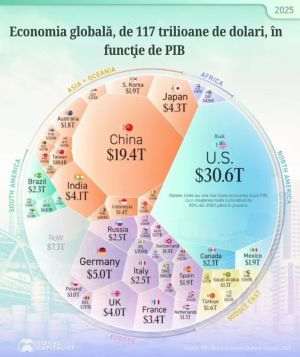The citizens of the member states of the European Union were the guinea pigs of the companies Astra Zeneca and Pfizer regarding the anti-Covid 19 vaccines, with the agreement of the European Medicines Agency (EMA), it appears from the audit report published yesterday by the European Court of Auditors regarding the activity of this agency of the European Center for Disease Prevention and Control (ECDC) during the pandemic.
According to the experts of the European Court of Auditors (ECA), Great Britain (state where the company Astra Zeneca has its headquarters and laboratory) and the USA (country where the company Pfizer has its headquarters and production units) benefited from a faster approval of vaccines anti-Covid, due to the procedure for issuing authorizations for use in emergency situations. The cited document states: "Authorizations of this type allow for the faster approval of certain treatments for which there were indications of possible effectiveness against COVID-19, even in the absence of sufficient data for a conditional authorization. (...) The EMA agreed to use the results of clinical trials covering a period of less than two months after vaccination as the basis for the initial marketing authorisation, provided that follow-up data were provided immediately after authorisation. (...) As a result, most of the vaccines against COVID-19 were authorized for marketing in the EU either before they were first authorized in a non-EU jurisdiction or within days or weeks afterwards. The time interval between the submission of a formal application for authorization and the issuance of the EMA opinion was much shorter than for other new vaccines".
European auditors also note that EMA cited in its assessments the limited availability of treatments, the severity of the disease and the 70-95% effectiveness of vaccines as reasons for issuing a positive opinion, even though the duration of protection and effectiveness against transmission remained unclear.
"All vaccines against COVID-19 were unanimously recommended. The Commission's decision to authorize a particular vaccine or treatment was always taken a few days after the EMA's recommendation, sometimes even on the same day," the ECA report states.
• Vaccines purchased on the basis of clinical trials conducted outside the EU
Practically, from the above, it appears that the conditional authorization granted to the companies Astra Zeneca and Pfizer was based on clinical studies of a maximum of two months, contrary to all the medical norms in force globally and all the recommendations until then from the World Health Organization . The short time of the clinical trials represents, in the opinion of some health experts, a high risk regarding the use of the respective vaccines, which could have led to medical problems for the vaccinated people.
This is also mentioned by the ECA auditors in the prepared report: "When testing vaccines, effectiveness is assessed by comparing the number of people who develop the outcome of interest in the vaccinated group with that in the placebo group during the observation period. It is the standard method for evaluating the effectiveness of vaccines, and the observation period was about two months. Subsequent data showed that efficacy against infection was significantly lower over a longer period, particularly against new variants, but protection against severe disease was longer-lasting."
Moreover, although the European Medicines Agency has tried to promote the conduct of clinical trials in the EU, it has not succeeded and as a result has had to rely largely on those conducted outside the EU bloc.
"Given that the most important clinical trials for vaccines against COVID-19 were mainly conducted outside the EU, they were only authorized by authorities outside the EU", the ECA report states.
Practically, from this paragraph it appears that the EMA and the European Commission have agreed to the authorization and purchase of anti-Covid vaccines based on clinical trials conducted only in the USA and Great Britain, and these for a maximum period of two months.
• Flexibility regarding the authorization of vaccines, without physical inspections at the manufacturing companies and at the site of the clinical trials
European auditors also say: "The Commission, EMA and heads of medicines agencies have agreed that from April 2020 some regulatory flexibility will apply to clinical trials, remote inspections and the extension of good practice certificates. (...) During the pandemic, compliance checks were often carried out remotely. The number of inspections on good clinical and manufacturing practices has decreased due to travel and safety restrictions, while good pharmacovigilance practice inspections remained at pre-pandemic levels. This has led to increased inspection backlogs for all products."
What the ECA report does not say is that that flexibility was necessary for the fast approval of the two vaccines made by Pfizer and Astra Zeneca. Through the lens of this flexibility, the values in the adverse reaction report can be interpreted. Thus, during 2021 EMA received and analyzed 1.68 million reports (out of a total of 3.5 million at European level) regarding adverse reactions to vaccines against COVID-19. In 2022, this number rose to 1.14 million reports (out of a total of 2.9 million), and in 2023 to 220,000 (out of 1.9 million), with the mention that in these two years the number of vaccinated people down significantly compared to the first year - 2021 - in which the Pfizer and Astra Zeneca vaccines were accessible on the European market.
• ECDC underestimated the severity of the pandemic, in the first weeks after reporting the presence of Sars-Cov 2 in China
As for the ECDC, the ECA auditors claim that for several weeks after China reported the first cases of COVID-19, the European Center underestimated the seriousness of the situation. It subsequently rapidly stepped up its response, developing several new initiatives such as pandemic modeling.
The ECA report states: "One week after China alerted WHO on 31 December 2019 to an outbreak of pneumonia cases of unknown origin in Wuhan, ECDC published its first threat assessment note, stating that, « given that there is no indication of human-to-human transmission and no cases detected outside of China, the probability of introduction into the EU is considered low but cannot be ruled out.' The agency activated phase 2 (alert) of the emergency plan, before briefly reverting to the lowest severity phase (monitoring) on January 14, after a second risk assessment found that "there are no clear indications of sustained human-to-human transmission". But just one week later, the ECDC activated level 1 of the acute phase, moving to the highest level on 31 January and remaining there until June 2022. On 14 February 2020, less than a month before the EU's of the first measures to limit the movement of people, the ECDC still considered that "the risk associated with SARS-CoV-2 infection for the population in the EU/EEA and the United Kingdom is currently low". Even as early as March 2020, the ECDC assessed the risk to the EU population as low to moderate. Most of the national Centers for Disease Control and Prevention, including the US Centers for Disease Control and Prevention, also initially underestimated the severity of the COVID-19 pandemic. In its rapid risk assessment on 12 March 2020, three days after Italy imposed nationwide restrictions on the movement of people, the ECDC acknowledged that "immediate specific actions" were needed.
The ECA auditors also found that following these measures the data reported to ECDC was of limited quality and there were notable differences between the information that countries could report, and national decision makers did not always heed its cautious recommendations and, sometimes late. The cited document also shows that in 2020 the ECDC began to publish communications intended for the public, but most publications continued to be addressed to public health professionals and less to citizens and the media.

























































